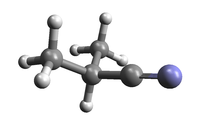|
The state v30 = 1 is the lowest one.
It is quite isolated. The experimental data have been
taken from
(1) B. E. Arenas, S. Gruet, A. L. Steber,
B. M. Giuliano, and M. Schnell,
2017, Phys. Chem. Chem. Phys., 19 1751.
Initial parameters were taken
from
(2) H. S. P. Müller, A. Coutens, A. Walters,
J.-U. Grabow, and S. Schlemmer,
2011, J. Mol. Spectrosc., 267 100.
Assignments are a tad different here with added
asymmetry components. One line was omitted because
it was somewhat away from the predictions.
14N hyperfine splitting may be resolvable
for some transitions at MW frequencies, but is
unlikely to be resolved in astronomical observations.
The HFS pattern is expected to be very close to that
of the ground vibrational state, see e069506.cat.
Predictions should be sufficient for secure
identification in the ISM up to 200, possibly 300 GHz.
They have been truncated at J = 50.
Predictions with calculated uncertainties exceeding
0.2 MHz should be viewed with caution.
NOTE: The partition
function does not take into account any vibrational
corrections yet. Information for a posteriori
correction should be provided soon.
The dipole moment components were assumed to agree
with those of the main species, see e069506.cat.
|
